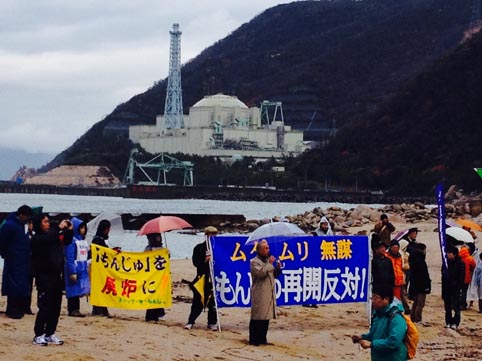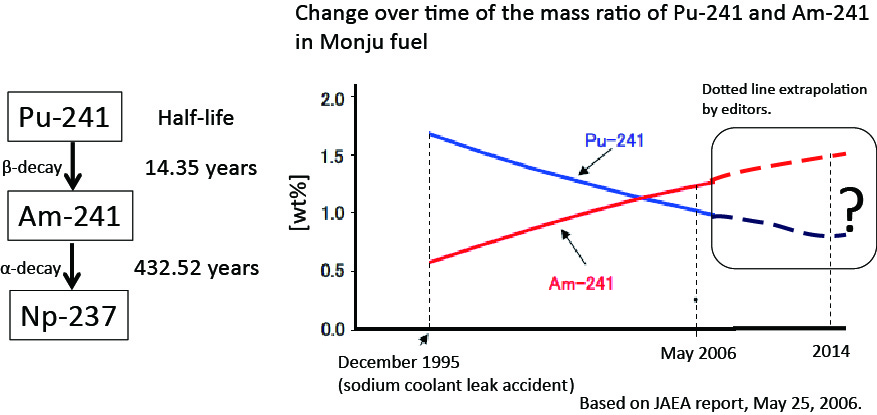Recent Shifts in Monju Policy Nuke Info Tokyo No. 158
the nominal purpose of reducing the volume of radioactive waste
 |
| Rally against the Monju Reactor, 2013 |
Introduction
The fast breeder reactor Monju has been in a state of shutdown since the sodium coolant leak accident in December 1995. The reactor managed a zero-output trial restart on May 2010, but in August of the same year an in-vessel transfer machine, part of the equipment for fuel replacement, fell into the reactor, which is still shut down. The policy indicated in the Democratic Party of Japan (DPJ) government’s Innovative Strategy for Energy and the Environment (2012) was to bring the research to an end after experimental operation of the reactor for about five years followed by a summary of the outcomes, but in September 2013 the Abe administration overturned this research termination by coming out with a Monju Research Plan.
Monju Research Plan
The research plan was put together by the Atomic Energy Science and Technology Commission Monju Research Plan working group (chaired by Hajimu Yamana) under the supervising ministry, Ministry of Education, Culture, Sports, Science, and Technology (MEXT). According to the DPJ government’s Innovative Strategy for Energy and the Environment, “With international cooperation, Monju will be used to summarize the outcomes of fast breeder reactor development and carry out research aimed at reducing the volume of long-lived radionuclides in nuclear waste, and a research plan with a limited term of years will be formulated and implemented for that purpose, the research being terminated once the outcomes have been confirmed.” The Strategy also stated, however, that, “Treatment technology for spent nuclear fuel for the purpose of reducing the volume of nuclear waste products, and R&D on burner reactors, will be promoted.”
Until now, the breeder reactor has been held up as the kind of reactor resource-poor Japan should be aiming for, but the content of the plan shown above indicates no outlook for the practical realization of the fast breeder. What it does indicate is a gradual switch to nuclear waste volume reduction as a means of continuing the research. The breeding function is unnecessary for waste volume reduction, and thus there seems to be an awareness of a changeover from a fast breeder reactor to a fast reactor. Furthermore, Japan is also participating in the international R&D program for the fourth generation reactor (GEN-IV). It would seem that the changeover from the fast breeder reactor to the fast reactor is taking place bit by bit without any open decision-making. The Research Plan uses the ambiguous format “fast breeder reactor/fast reactor.” In the sponsor’s greeting at “The International Forum on Peaceful Use of Nuclear Energy, Nuclear Non-Proliferation and Nuclear Security,” held on December 3, 2013, the President of the Japan Atomic Energy Agency (JAEA), Shojiro Matsuura, spoke of Monju as a “prototype fast reactor.” Since the head of the organization that has constructed and operated Monju uses this expression, we may say that the changeover to a fast reactor is now clear.
The finalized “Research Plan” gives approximately six years as the “period for summarizing outcomes.” After operating the reactor for four months, a period of eight months is then provided for reactor maintenance along with data collection and analysis in accordance with a list of desired outcomes, one year being one “cycle.” Therefore, after a scheduled one-year performance test operation, it is intended that the reactor will be put through five full-fledged operational cycles.
After the results from the six-year study are compiled, a decision will be made on whether or not to continue the Monju research, based on energy policy priorities and international conditions.
It is said that the Monju facility will be utilized for research on reduction of the volume of nuclear waste, but because in actuality the reactor was shut down for a long period, it contains much americium, so in a sense this only amounts to a positive-sounding expression for the necessity of using aging fuel. That is to say, since considerable time has passed since the plutonium that was going to be used as the fuel for Monju was reprocessed (plutonium extraction), they have little choice but to use fuel that has a high americium content. Theoretically, americium undergoes nuclear fission by bombardment with fast neutrons (1 MeV or greater), so this is one of the research issues that is said will be verified at Monju.
It is doubtful whether sufficient nuclear fission would take place in a fast reactor. The energy of neutrons in a reactor is not uniform, and depending on the circumstances, americium may absorb neutrons without undergoing fission. In that case, americium will change into a longer-lived radionuclide.
 |
| The fissile material in the Monju fuel, Plutonium-241, decays naturally to Americium-241 at a half life of about 14 years. |
Organizational self-reformation
A research plan has been made, but is the organizational system capable of implementing it?
The accidental sodium leak and fire in 1995 was the result of a simple design error in the sheath of a thermocouple (for which Toshiba was responsible) used for measuring the temperature of molten sodium flowing through the pipes. Sodium leaked out by an unanticipated route, resulting in a fire. The accident involving an in-vessel transfer machine in 2010 was the result of a failure to enforce measures to prevent rotation of a device used for grasping and lifting fuel assemblies within the reactor, and it was also a simple design error on the part of Toshiba. After the 1995 accident, thorough safety inspections including confirmation of facility conformity to drawings and specifications were conducted, but they failed to detect the simple design error in internal relaying equipment. Problems occurred in 2010, just prior to restarting the reactor for a performance test run. These included substantial errors and failures to check the sodium leak detection equipment. Improvements should have been made by investigating the fundamental causes of these problems, but 14,316 subsequent inspection failures have come to light since late 2011.
Because of the lack of a suitable organizational system for running Monju, JAEA conducted its own analysis of the fundamental factors causing trouble and published Self-reformation –A Path Toward Rebirth–. Self-reformation was compiled by Shojiro Matsuura, who assumed presidency of the JAEA in May 2013. Matsuura previously headed the former Japan Atomic Energy Research Institute and was chief of the Nuclear Safety Commission from 2000 to 2006.
The JAEA has analyzed the fundamental causes of the accidents and problems thus far and has made organizational reform efforts, but even so, accidents and problems have continued to recur. Their analysis of the fundamental causes is nowhere to be seen in Self-reformation, and the recommendations for dealing with these issues remain those that were formerly made.
A general safety inspection tracing back to the design documents was conducted only once during the general safety inspections at Monju after the accident in 1995, and has not been conducted since then. Considering the current situation in which the knowledge of the people who were involved initially is not being passed along, the author believes that a new general safety inspection with a retrospective review of the design documents is now necessary again.
Monju was developed using the so-called “convoy system” method. That is to say, the former Power Reactor and Nuclear Fuel Development Corp. was in charge of dividing up orders, with primary equipment orders (nuclear reactors) going to Mitsubishi Heavy Industries, secondary orders (sodium coolant systems for transferring heat from the primary equipment to the tertiary) to Toshiba, and tertiary orders (water and steam equipment) to Hitachi, with each of these companies responsible for the design, installation and maintenance of their respective equipment. Each of these manufacturers further subcontracted their work, entrusting actual maintenance work to the respective companies that had installed the equipment. This kind of order placement structure makes coordination among the manufacturers difficult. In addition, the people initially involved in the ordering side of the system as well as the people involved substantially in the design and installation among the manufacturers are mostly at retirement age, so technical knowledge and know-how will not be sufficiently conveyed. The outlook for success of the reformation is extremely dim.
| Fast breeder reactor (FBR) | Breeding plutonium to enhance energy security Focus on economic efficiency |
| Fast reactor (FR) | No plutonium breeding Focus on reduction of volume of radioactive waste |
The Nuclear Regulatory Commission’s Response
The research plans and self-reformation all presuppose the renewed operation of Monju. From September 2013, new standards came into effect, and standards for experimental reactors are tentatively in order. Even so, however, they do not require the installation of an emergency reactor core cooling system at Monju. The risk of a runaway nuclear accident at Monju has been pointed out, but the standards for accidents peculiar to fast breeder reactors are “under consideration.” Renewed operation with no standards in place would be unthinkable.
Meanwhile, the Nuclear Regulatory Commission is conducting an inspection of the fracture zone at the Monju site. It is taking the position that it is necessary to cover an area greater than that examined in the earthquake resistance ‘back check’ conducted by the JAEA in 2008. The JAEA maintains that the fracture zone at the site is not active, but the standards under the new regulations require consideration of whether or not slips could occur in association with movement of the main fault. These considerations will take time, so it will probably be at least several years before performance tests can begin at Monju.
If that is the case, 30 years will have passed since the Monju reactor was built. Such an old reactor, combined with such dubious conveyance of technical knowledge would mean that operation of this nuclear reactor would entail extremely high risks.
 |
| Location of Monju and nearby nuclear power plants |
We Need a Comprehensive Appraisal of Monju!
First of all, a comprehensive appraisal is needed regarding the suitability of restarting the Monju reactor, the possibility of reducing the amount of nuclear waste, and whether or not this research is a suitable use of government funds. This appraisal needs to include a comprehensive assessment of the propriety of spending several trillion more yen on fast breeder reactor R&D when two trillion yen have already been invested, including into Monju, in the unfulfilled hopes of practical use. It must also consider the danger of a serious accident at Monju, given those that occurred at the nuclear plants in Fukushima. The fact that the MEXT is calling together scholars to promote Monju and drawing up research plans constitutes a serious problem.
Hideyuki Ban (Co-director of CNIC)
[Notes]
Monju research plans (in Japanese):
www.mext.go.jp/b_menu/shingi/gijyutu/gijyutu2/061/shiryo/1339409.htm
The Japan Atomic Energy Agency’s reformation plans (in Japanese):
www.jaea.go.jp/02/press2013/p13092601/index.html
